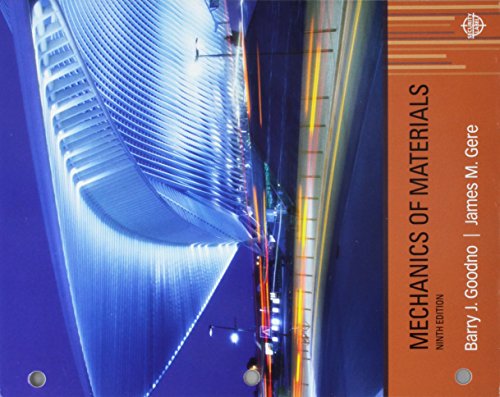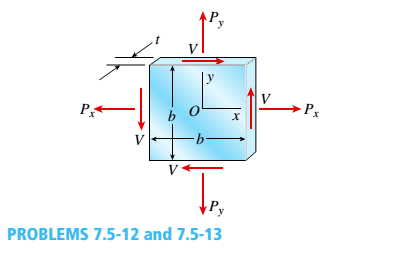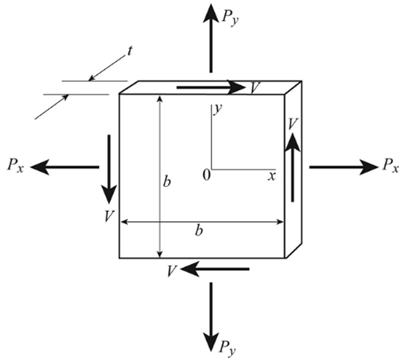
Concept explainers
-12 A square plate of a width h and thickness t is Loaded by normal forces Pxand P and by shear forces V, as shown in the figure. These forces produce uniformly distributed stresses acting on the side faces of the plate.
(a) Calculate the change AV in the volume of the plate and the strain energy U stored in the plate if the dimensions are ft = 600 mm and f = 40 mm; the plate is made of magnesium with E = 41 GPa and v = 0,35; and the forces are Pv= 420 kN, P, = 210 kN, and V = 96 kN. (b) Find the maximum permissible thickness of the plate when the strain energy U must be at least 62 J. [Assume that all other numerical values in part (a) are unchanged.]
(c) Find the minimum width b of the square plate of thickness / = 40 mm when the change in volume of the plate cannot exceed 0.018% of the original volume.

(a)
The change
The strain energy
Answer to Problem 7.5.12P
The change
The strain energy
Explanation of Solution
Given information:
The normal force acting on the x-direction is

Figure (1)
Write the expression for the volumetric strain.
Here, the change in the volume of the plate is
Write the expression for the strain energy stored in the plate.
Here, the strain energy stored in the plate is
Write the expression of the original volume of plate
Here, the width of the plate is
Write the expression for the stress along x-direction.
Here the normal force along x-direction is
Write the expression for the stress along y-direction.
Here the normal force along y-direction is
Write the expression for the area of the plate.
Write the expression for the shear modulus.
Write the expression of the volumetric strain.
In the following plate we have two surface area at which shear force is applied so, the surface area for the shear stress is
Write the expression of the shear stress.
Calculation:
Substitute
Substitute
Substitute
Substitute
Substitute
Substitute
Substitute
Substitute
Substitute
Conclusion:
The change
The strain energy
(b)
The maximum permissible thickness of the plate.
Answer to Problem 7.5.12P
The maximum permissible thickness of the plate is
Explanation of Solution
Given information:
The strain energy
Write the expression of the strain energy stored in the plate.
Calculation:
Substitute
Conclusion:
The maximum permissible thickness of the plate is
(c)
The minimum width
Answer to Problem 7.5.12P
The minimum width
Explanation of Solution
Given information:
The thickness of square plate is
Write the expression of the condition of the change in the length.
Calculation:
Substitute
Substitute
Substitute
Conclusion: The minimum width
Want to see more full solutions like this?
Chapter 7 Solutions
Bundle: Mechanics Of Materials, Loose-leaf Version, 9th + Mindtap Engineering, 1 Term (6 Months) Printed Access Card
- Note: Please provide a clear, step-by-step simplified handwritten working out (no explanations!), ensuring it is done without any AI involvement. I require an expert-level answer, and I will assess and rate based on the quality and accuracy of your work and refer to the provided image for more clarity. Make sure to double-check everything for correctness before submitting thanks!. Question: (In the image as provided)arrow_forwardNote: Please provide a clear, step-by-step simplified handwritten working out (no explanations!), ensuring it is done without any AI involvement. I require an expert-level answer, and I will assess and rate based on the quality and accuracy of your work and refer to the provided image for more clarity. Make sure to double-check everything for correctness before submitting thanks!. Question: The rectangular gate shown below is 3 m wide. Compute the force P needed to hold the gate in the position shown.arrow_forwardNote: Please provide a clear, step-by-step simplified handwritten working out (no explanations!), ensuring it is done without any AI involvement. I require an expert-level answer, and I will assess and rate based on the quality and accuracy of your work and refer to the provided image for more clarity. Make sure to double-check everything for correctness before submitting thanks!. Question1: If the following container is 0.6m high, 1.2m wide and half full with water, determine the pressure acting at points A, B, and C if ax=2.6ms^-2.arrow_forward
- Please read the imagearrow_forwardChapter 12 - Lecture Notes.pptx: (MAE 272-01) (SP25) DY... Scoresarrow_forwardConsider a large 6-cm-thick stainless steel plate (k = 15.1 W/m-K) in which heat is generated uniformly at a rate of 5 × 105 W/m³. Both sides of the plate are exposed to an environment at 30°C with a heat transfer coefficient of 60 W/m²K. Determine the value of the highest and lowest temperature. The highest temperature is The lowest temperature is °C. °C.arrow_forwardSketch and explain a PV Diagram and a Temperature Entropy Diagram for a 4 stroke diesel engine please, please explain into detail the difference bewteen the two and referance the a diagram. Please include a sketch or an image of each diagramarrow_forwardDraw left view of the first orthographic projectionarrow_forwardSketch and Describe a timing diagram for a 2 stroke diesel engine emphasis on the 2 stroke as my last answer explained 4 stroke please include a diagram or sketch.arrow_forwardA 4 ft 200 Ib 1000 Ib.ft C 2 ft 350 Ib - за в 2.5 ft 150 Ib 250 Ib 375 300 Ib Replace the force system acting on the frame. shown in the figure by a resultant force (magnitude and direction), and specify where its line of action intersects member (AB), measured from point (A).arrow_forwardA continuous flow calorimeter was used to obtain the calorific value of a sample of fuel and the following data collected: Mass of fuel: 2.25 kgInlet water temperature: 11 ° COutlet water temperature 60 ° CQuantity of water: 360 Liters Calorimeter efficiency: 85%Calculate the calorific value of the sample ( kJ / kg ). ive submitted this question twice and have gotten two way different answers. looking for some help thanksarrow_forward15 kg of steel ball bearings at 100 ° C is immersed in 25 kg of water at 20 ° C . Assuming no loss of heat to or from the container, calculate the final temperature of the water after equilibrium has been attained.Specific heat of steel: 0.4857 kJ / kg / ° KSpecific heat of water: 4.187 kJ / kg / ° Karrow_forwardarrow_back_iosSEE MORE QUESTIONSarrow_forward_ios
 Mechanics of Materials (MindTap Course List)Mechanical EngineeringISBN:9781337093347Author:Barry J. Goodno, James M. GerePublisher:Cengage Learning
Mechanics of Materials (MindTap Course List)Mechanical EngineeringISBN:9781337093347Author:Barry J. Goodno, James M. GerePublisher:Cengage Learning
